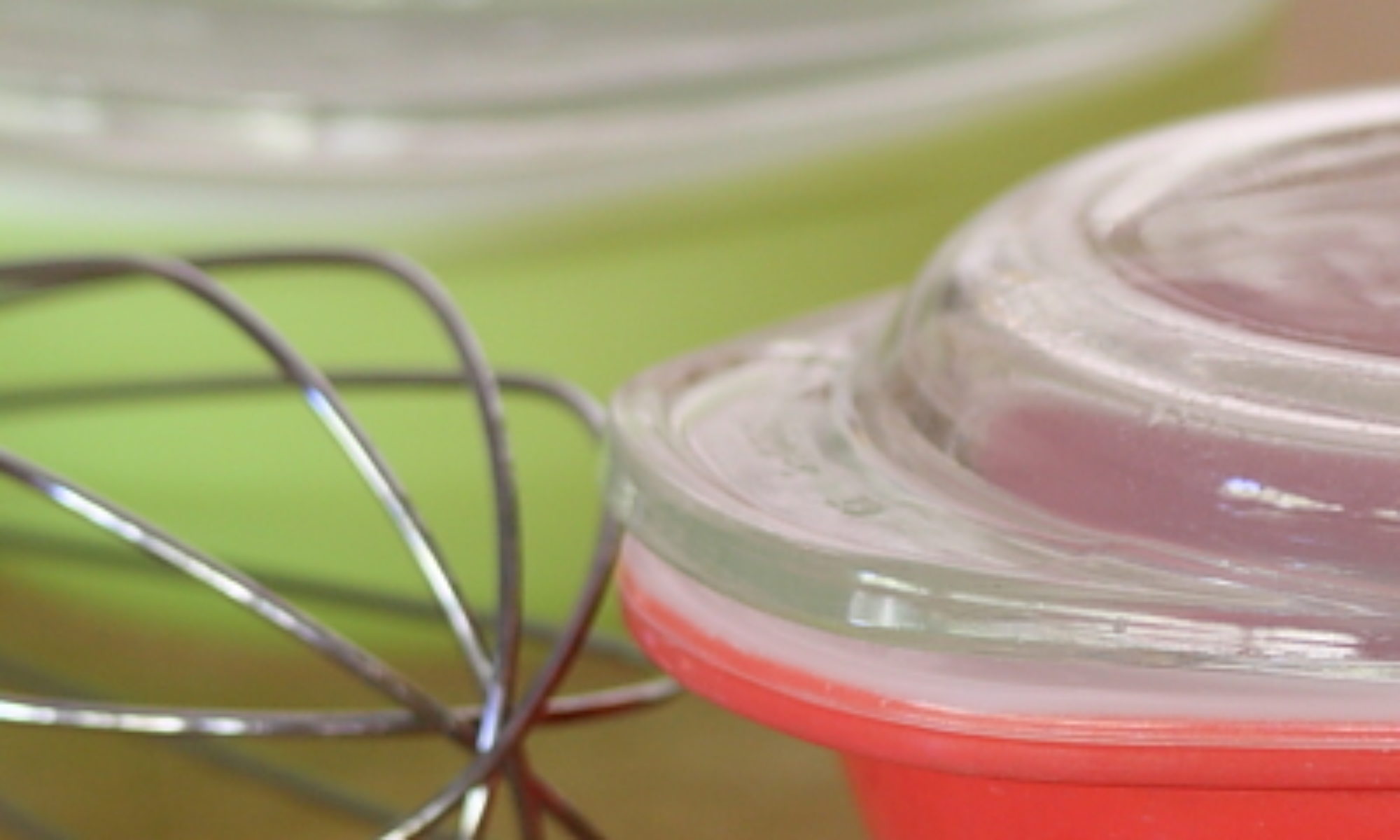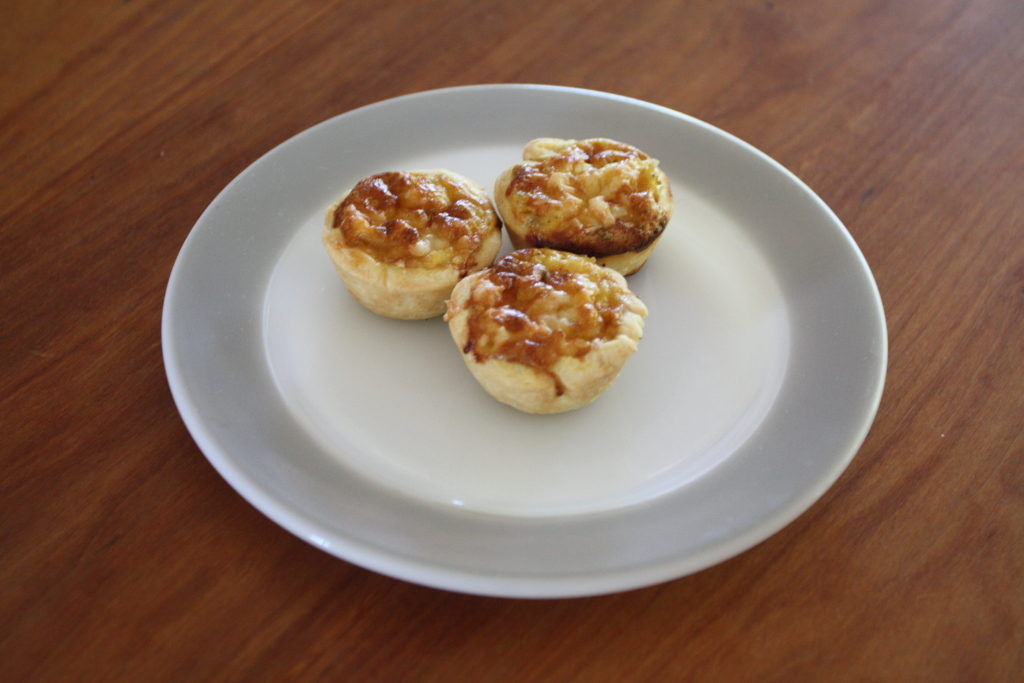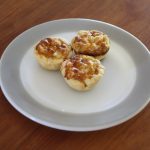
We’ve been getting onions and more onions from the CSA each week. So much so that our official Scratchin’ It onion bowl spilled over onto the counter. We had to use those onions and quick. At the same time, we wanted to bring down some small savory treats for the volunteers who support our Monday night walks — we try to bring something when we volunteer; that way, we can have a snack and share it, too. It all came together when we remembered that we’ve wanted to make an Onion Tart for quite a while, perhaps years.
Instead of a tart, we made small tartlets, bite-sized onion tarts. It’s more trouble, but you can make a full-size (10-inch tart) by just using 1 Pâte Brisée, and blind baking it until golden brown, filling with the onion mixture, topping with cheese, and baking for 45-55 minutes in a 375°F oven.
So, whichever you’re making, let’s get Scratchin’.
Alsace Onion Tartlets
Ingredients
- 2 crusts pâte brisée chilled and ready to roll (see note)
- 3 Tbs unsalted butter
- 1 1/2 pounds onions quartered and sliced very thinly (1/16th inch)
- 1 tsp kosher salt divided
- 3/4 tsp freshly ground black pepper divided
- 3/4 cup crème fraîche (or heavy cream) (180 g) (see note)
- 3 large eggs
- 2 egg yolks
- 1/2 cup Gruyère cheese, finely grated (3 ounces)
- 1/4-1/2 tsp freshly grated nutmeg
- 1 Tbs dried thyme
Instructions
- Melt butter in a large skillet over medium heat. Add onions, 1/2 tsp salt, and 1/4 tsp black pepper and cook, stirring, until wilted. Cover, and continue to cook, stirring every few minutes, until onions are very soft and pale golden, about 20 minutes. Remove from heat and cool completely.
- Working with one crust at a time, on a lightly-floured work surface, roll to a thickness of 1/8 inch. Using a 2 1/2 inch round cutter, cut as many disks as possible. Lightly roll each disk thinner into a 3-inch circle. Press into mini-muffin pan. You can re-roll scraps once or twice.
- When all the crusts are rolled, place crusts in freezer for at least 30 minutes.
- Preheat oven to 350°F.
- In a large bowl, whisk together crème fraîche, eggs and yolks, nutmeg, thyme, remaining 1/2 tsp salt, and remaining 1/2 tsp black pepper. Stir in the onions.
- Remove crusts from freezer and fill with about 1 tablespoon of filling each. Top with grated cheese.
- Bake until crusts are golden, filling is puffed and set, about 25 minutes. Let cool in the pan for 15-30 minutes.
- Serve either warm or room temperature.
Notes
Ingredient discussion:
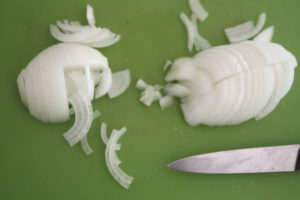
The list of ingredients scream French, don’t they? But, don’t worry, there’s nothing difficult. Pâte Brisée is pie crust; the one we link to is the best we’ve had. And the easiest, too. Crème fraîche, well, that’s nothing but a mild sour cream, which you can make yourself. We started making our own after we bought a pack at Whole Food$. We’ll never do that again — our wallet is still hurting. If you’re not willing to make sour cream, just use heavy cream. Gruyère cheese is similar to Swiss; either would work. As always, use those great-tasting eggs from free-range hens. Healthy hens mean healthy eggs.
Procedure in detail:
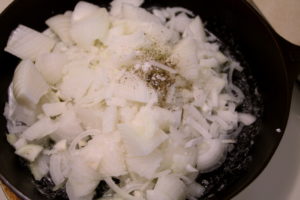
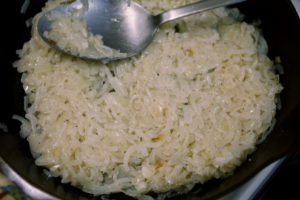
Cook onions. Melt the butter in a large heavy skillet over medium heat. Cooking onions slowly will maximize their sweetness, so it helps to have a heavy-bottomed skillet. We like to use a large cast iron skillet, but other skillets will work, too. Once the butter has melted, add the onions and stir. Sprinkle 1/2 teaspoon of salt and 1/4 teaspoon of black pepper over the onions — the salt will help the onions release their juices, so they’ll cook faster — and cook, stirring until they’re wilted and releasing liquid. Cover the skillet and cook the onions, stirring every couple of minutes, until they’re very soft and starting to turn golden. You don’t want a brown color, which will make the onions bitter, just a light golden brown. You might have to lower the temperature near the end to keep the onions from sticking and burning. Once golden, remove from heat and let cool completely.
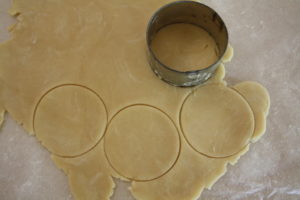
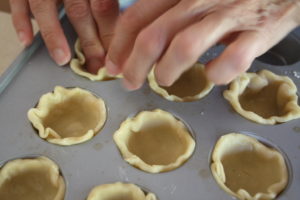
Roll crust. Working with one piece of dough at a time, roll the crust out to a thickness of 1/8 inch. We rolled our crust on waxed paper in case it warmed and had to be chilled — we’d just pick up the waxed paper and pop the whole thing into the refrigerator. Rolling on a lightly floured surface will be fine, too. Once rolled, cut out as many 2 1/2-inch circles as possible. Gather the scraps and refrigerate to re-roll later. Take each circle and roll it even thinner, making a circle about 3 1/2 inches in diameter. We find that it’s easier to roll the circles thin than it is to roll an entire batch of dough thin. Place each circle in a hole of a mini-muffin pan and press in lightly. Continue with the remaining circles, then place the pan in the freezer while you roll the next batch of dough. We find that you can re-roll the scraps once on their own, but, the second time, we roll them with the next batch of dough. Obviously, if you’re making a 10-inch tart, fit the crust into an appropriately-sized tart pan.
Freeze. When the crusts are all rolled out, place in the freezer for at least 30 minutes to allow the gluten to relax.
Blind bake. If you’re making a full-sized tart, follow these instructions to blind bake your crust. With tartlets, no blind baking is needed.
Preheat oven to 350°F. If you’re making a full-sized tart, preheat the oven to 375°F.
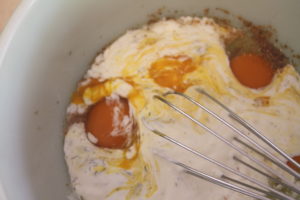
Make filling. The filling for these tartlets is easy. In a large bowl, whisk together the crème fraîche, eggs and yolks, nutmeg, thyme, remaining 1/2 tsp salt, and remaining 1/2 tsp black pepper. It’ll seem as if it might be too liquid-y, but it’ll be fine, especially when the onions are in.
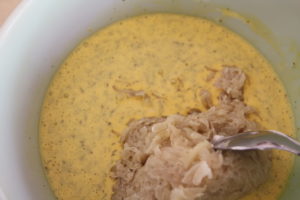
Add onions. Fold the onions into the filling. Now you can see why we let the onions cool completely. We wouldn’t want to add hot onions to a custard-like filling; the eggs in it would cook in spots, leading to a lumpy filling.
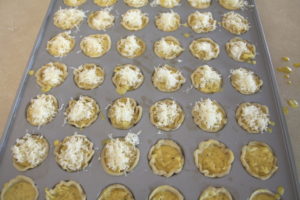
Fill tartlets. Remove the tartlet shells from the freezer and scoop about 1 tablespoon of filling into each shell. It should come up to the top of the shell. If you’re making a full-sized tart, simply scoop the filling into your baked tart shell.
Top. Sprinkle about a teaspoon of grated cheese on top of each tartlet, spreading it evenly across the top. Our grated cheese clumped a bit, so we didn’t get it perfect, but, once baked, you can’t tell the difference, anyway.
Bake. Slide into the oven and bake until golden brown. Pay attention to the edges of crust peeking out; they should be golden brown, too. It should take about 25 minutes. For even baking, rotate the pan from front to back halfway through. A full-sized tart will take about 40 to 50 minutes.
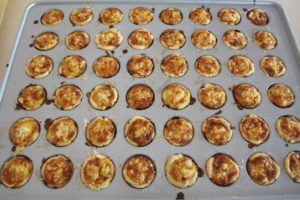
Cool. Let the tartlets cool in the pan for about 15-30 minutes before removing them. Serve either warm or at room temperature to your delighted diners.
Le parfait! (Thanks to Google translate, we can make it seem as if we know the French word for “perfect.”). These really were perfect. One of the issues with tiny tartlets is that they have a lot of crust compared to the amount of filling, making them seen dry. But not these. With all that onion, they stayed nice and moist, and delicious. Were they oniony? Not really; by frying the onions until they’re golden, the strong onion taste disappears, leaving a nice sweet, slightly nutty taste. We love them and so will you. Cinq étoiles.
